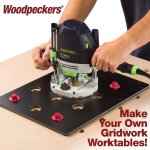Packard said:
On occasion I read about the PARF guide system and to be honest, I don't get it.
The only thing I ever wanted was a template with 1.00" diameter holes appropriately placed for a MFT top. It need not cover the entire top; 4 rows would be enough. And then it could be shifted.
Used with a router and 1.00" O.D. template guide (7/8" I.D.) it would accommodate a 0.750" diameter router bit. The only accessory needed would be two bench dogs with 3/4" at one end and 1" at the other for indexing to the next station.
It would be made from 1/4" hardboard or any other dimensionally stable sheet good. It certainly could be sold for the price of a PARF system, and it would be easier to use and should be as accurate as the CNC that made the template.
If there is something I am missing, let me know. But PARF is starting to look like a hobby to me.
Parf guide system is about replacing a need for a quality CNC and a need to long-distance ship heavy/big pieces of MDF or plywood if you NEED/WANT an MFT-class accuracy and MTF-compatible hole pattern.
It makes sense for people who do not have (easy) access to a CNC shop, need to drill holes to existing table etc. using locally-available materials.
If none of these is a killer feature, it makes little sense to go Parf guide. If you just need the accuracy and have access to a CNC, go for it. If you have the money and MFT fits your bill size-wise, go for it and optionally use it as a template. If you do not need the accuracy, but want compatibility, just use the LR32 method. If you need neither, just mark your holes and route or drill them.
Ref it issues of folks. IMO the problem here is that Peter P make is look on his videos as if it was easy to make accurate holes. Oh yeah, compared to free-hand it is dead-easy. But that is STILL a skill/art.
IMO the Parf guide system should include a (knowingly) slightly smaller bit and the reamer. That is how engineers make accurate holes for centuries.
Ref reamer heating up: You need to use it slowly - as in hand-speed-slowly.
Overall IMO PGS II is a nice piece of engineering for allowing a hobby use to make a custom MFT-style furniture "on the cheap and compact". But it is no alternative to buying an MFT or having the slab made on a quality CNC. It is another option with its own limitations and requirements.

